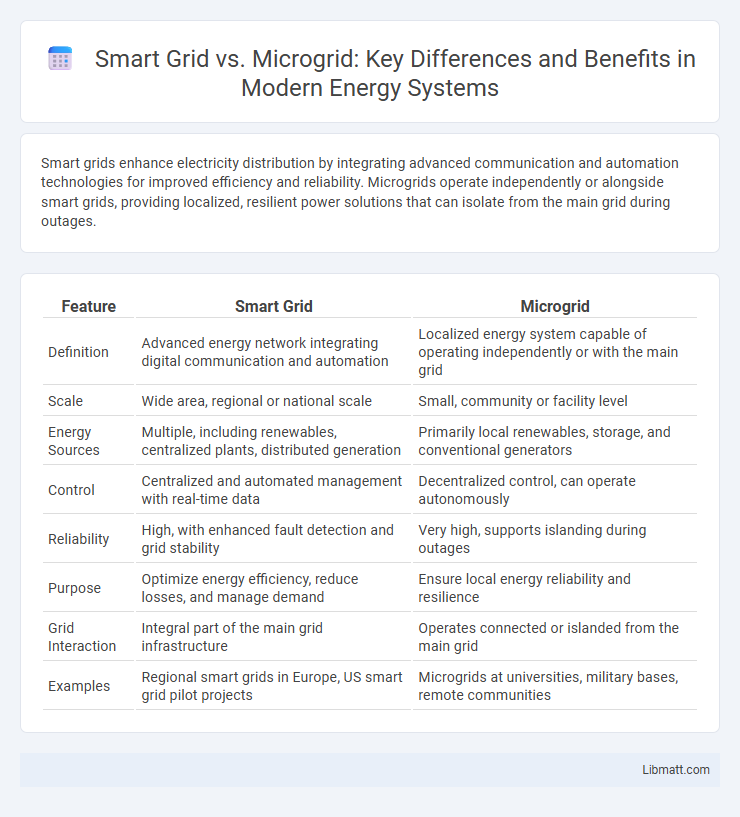Smart grids enhance electricity distribution by integrating advanced communication and automation technologies for improved efficiency and reliability. Microgrids operate independently or alongside smart grids, providing localized, resilient power solutions that can isolate from the main grid during outages.
Table of Comparison
| Feature | Smart Grid | Microgrid |
|---|---|---|
| Definition | Advanced energy network integrating digital communication and automation | Localized energy system capable of operating independently or with the main grid |
| Scale | Wide area, regional or national scale | Small, community or facility level |
| Energy Sources | Multiple, including renewables, centralized plants, distributed generation | Primarily local renewables, storage, and conventional generators |
| Control | Centralized and automated management with real-time data | Decentralized control, can operate autonomously |
| Reliability | High, with enhanced fault detection and grid stability | Very high, supports islanding during outages |
| Purpose | Optimize energy efficiency, reduce losses, and manage demand | Ensure local energy reliability and resilience |
| Grid Interaction | Integral part of the main grid infrastructure | Operates connected or islanded from the main grid |
| Examples | Regional smart grids in Europe, US smart grid pilot projects | Microgrids at universities, military bases, remote communities |
Introduction to Smart Grid and Microgrid
Smart Grid integrates advanced communication and automation technologies to optimize electricity distribution, enhance reliability, and enable real-time energy management across large power networks. Microgrid operates as a localized energy system capable of autonomous function, combining renewable sources, storage, and load management to improve resilience and support grid independence. Your energy infrastructure benefits from understanding Smart Grid's broad scalability and Microgrid's focused, flexible control in enhancing sustainability and efficiency.
Key Differences Between Smart Grid and Microgrid
Smart Grid integrates advanced communication and automation technologies across the entire power network to enhance efficiency, reliability, and sustainability on a large scale. Microgrid operates as a localized energy system capable of independent operation, enabling resilience and energy management within a defined area such as a campus or neighborhood. Key differences include scale, control autonomy, and grid interaction, with Smart Grid emphasizing broad grid optimization while Microgrid prioritizes localized generation and consumption balance.
Core Components of a Smart Grid
Smart Grid core components include advanced metering infrastructure (AMI), communication networks, and distribution automation systems that enable real-time monitoring and two-way communication between utilities and consumers. Integrated sensors, smart meters, and grid automation devices enhance grid reliability and facilitate efficient energy management. These components collectively support dynamic load balancing, fault detection, and seamless integration of renewable energy sources.
Main Features of a Microgrid
A microgrid is a localized energy system that can operate independently or in conjunction with the traditional smart grid, enhancing energy reliability and resilience. Key features include the ability to integrate distributed energy resources like solar panels and battery storage, maintain autonomous control during outages, and optimize energy consumption for a specific community or facility. Your energy management becomes more efficient as microgrids provide real-time monitoring, demand response capabilities, and seamless transition between grid-connected and island modes.
Benefits of Smart Grids
Smart grids enhance energy efficiency by enabling real-time monitoring and adaptive management of electricity flow across the entire network, reducing outages and operational costs. They integrate renewable energy sources seamlessly, supporting sustainability goals while improving grid reliability and resilience. By leveraging advanced communication and automation technologies, smart grids empower you with greater control over energy consumption and facilitate demand response strategies.
Advantages of Microgrids
Microgrids offer enhanced energy resilience by operating independently from the main grid during outages, ensuring continuous power supply to critical loads. Your facility benefits from improved energy efficiency and reduced transmission losses due to localized generation and distribution. Microgrids also enable integration of renewable energy sources, lowering carbon emissions and supporting sustainability goals.
Challenges Facing Smart Grids
Smart grids encounter challenges including cybersecurity threats, integration complexity with renewable energy sources, and aging infrastructure requiring modernization. Managing large-scale data for real-time monitoring and ensuring grid stability amid fluctuating energy inputs pose significant operational difficulties. Regulatory barriers and high initial investment costs also hamper widespread smart grid deployment and scalability.
Obstacles in Microgrid Implementation
Microgrid implementation faces obstacles including high initial investment costs, complex integration with existing smart grid infrastructure, and regulatory challenges that can delay deployment. Technical issues such as ensuring reliable power quality and managing energy storage also hinder widespread adoption. Addressing these barriers is essential to make your energy system more resilient and efficient within a smart grid framework.
Use Case Scenarios: Smart Grid vs Microgrid
Smart grids enable large-scale energy management by integrating renewable sources and optimizing electricity distribution across cities, improving reliability and efficiency for millions of users. Microgrids operate independently or alongside the main grid, providing localized energy resilience and tailored power solutions for critical infrastructure, campuses, or remote communities. Your energy strategy benefits from combining smart grid broad network control with microgrid-specific energy autonomy in emergency or off-grid scenarios.
Future Trends in Smart Grids and Microgrids
Future trends in smart grids emphasize advanced integration of AI-driven analytics and real-time data processing to enhance grid reliability and efficiency. Microgrids are evolving toward greater autonomy with decentralized energy resources, including increased deployment of renewable energy sources and energy storage systems. Both technologies are expected to leverage blockchain for secure energy transactions and promote enhanced grid resilience against cyber and physical disruptions.
Smart Grid vs Microgrid Infographic

 libmatt.com
libmatt.com